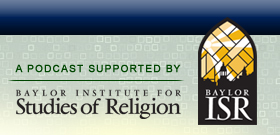

|
Lerone Martin on Preaching on Wax and Phonograph Religion  Date: November 13th, 2016
 For a few decades in the early-mid 20th century, the sermons of a number of African-American preachers were recorded on “wax” (or vinyl records) and distributed widely, a phenomenon that became known as “phonograph religion.” Prof. Lerone Martin, an assistant professor at the John C. Danforth Center for Religion & Politics at Washington University, joins us to discuss this fascinating period in history and bring along a couple audio clips for us to enjoy and analyze. Dr. Martin begins by explaining how he came to his dissertation project of examining “phonograph religion.” His upbringing in a religious household with many audio sources — radio, cassettes, CDs — piqued his interest and set him down an academic path to explore how “preaching on wax” all began. Lerone treats us to the story of Rev. James M. Gates as he makes a journey from Georgia to Columbia Studios in New York City to record a number of sermons. Amazingly, these recorded sermons sold upwards of 50,000 copies, which, when one considers the population of the United States and limited availability of phonographs (especially in poor rural areas), would be equivalent to a platinum album in today’s market (roughly a million copies). Prof. Martin lays out both the social, demographic, and religious landscape of African Americans in the first half of the twentieth century, noting that it was a period of migration from rural areas and into cities. Two strands of religious preaching emerge during this time — one associated with the black literati and that focused on a more urbane and educated approach to spiritual worship, and another that brought the folk worship practices of rural communities into the city. It is this latter stream that found a home in the phonographic recording medium, a method of distribution that was popular with the “common folk” and that lent itself well to the rhythmic preaching and use of music common in rural African America churches. We talk about the demographics and theological themes of phonographic preachers, noting that they tended to come from Southern Baptist or Pentecostal traditions instead of the African Methodist Episcopal (AME) churches and how issues of personal piety, “fire and brimstone,” and “proper” gender roles were emphasize in many of the recordings. We discover that Rev. Gates recorded a couple of his sermons on the same day, and in the same studio, that Bessie Smith and Louis Armstrong were recording “salacious” jazz and blues songs. This story prompts Tony to ask whether recording executives worried that promoting religious tracts that warned of the sinfulness of modern music might cut into the profits of the jazz side of the business. Lerone notes that many people listened to both and so long as the recordings sold well, labels such as Columbia, Okeh, and Merrit Records were happy to keep supplying them. Our conversation also covers how people used these recordings, often sharing them around the neighborhood or taking them on car and train trips (as many of the phonographs were hand cranked). The last portion of our conversation provides an audio taste of some of these sermons, with Dr. Martin explaining the relevance of each one. We hear Rev. FW McGee’s “Jonah in the Belly of the Whale” and J.C. Burnett’s “Downfall of Nebuchadnezzar,” estimated to be the highest selling sermon of that era. Lerone also explains how these sermons took on various social issues such as the concern over the rise of “chain stores” and how they might be displacing smaller “mom and pop” businesses in local communities. We hear part 1 of Rev. Gates’s sermon “Goodbye Chain Stores,” and Prof. Martin then discusses its characteristic style and significance. We note the interesting paradox that while Gates was critical of chain stores (such as Woolworth’s), the phonographs and recordings of these sermons were made more widely available because of these establishments, leading Lerone to note that embracing the medium of the culture that they often critiqued was a way of extending the evangelical reach of these pastors. We conclude with some thoughts on what Prof. Martin learned over the course of his studies, and he shares his surprise that he developed a growing respect for these preachers seeing them as very nuanced actors in a changing environment. Recorded: Nov. 9, 2016. Note: The audio clips used are freely available to the public on YouTube. Further links can be found below. RELATED LINKS Prof. Lerone Martin’s bio at the Danforth Center for Religion & Politics at Washington University (in St. Louis). Preaching on Wax: The Phonograph and the Shaping of Modern African American Religion, by Lerone A. Martin. RELATED AUDIO LINKS (connected to YouTube where more sermons than those listed can be found). “As An Eagle Stirreth Up Her Nest,” by Rev. Calvin “Black Billy Sunday” Dixon (first sermon recorded by an African-American pastor). “Death’s Black Train is Coming,” by Rev. James M. Gates (the first popular sermon recorded). “Downfall of Nebuchadnezzar,” by Rev. JC Burnett (probably the highest selling sermon of the pre-WWII era). “Jonah in the Belly of the Whale,” by Rev. FW McGee (as heard in podcast). “Goodbye Chain Stores: Part I” and “Part II,” by Rev. James M. Gates (part I heard in podcast). “Dry Bones in the Valley,” by Leora Gates (example of a female preacher). RELATED PODCASTS David Dixon on Religious Rhetoric and the Civil Rights Movement. Merisa Davis on Bill Cosby, Religion, and African American Churches. Darin Mather on Evangelicals and Racial Attitudes. James Patterson on MLK, Fulton Sheen, and Jerry Falwell. Tony Carnes on Jesus’s Auto Body (and Soul) Shop, Blessed Pizza, and NYC Religions Part II.
One Response to “Lerone Martin on Preaching on Wax and Phonograph Religion” |
 Search The Podcast
To search the podcast, type a term and click the Search button.
  Browse Podcast Categories
Select a category below to browse the podcast:
   |















[…] Lerone Martin on Preaching on Wax and Phonographic Religion. […]